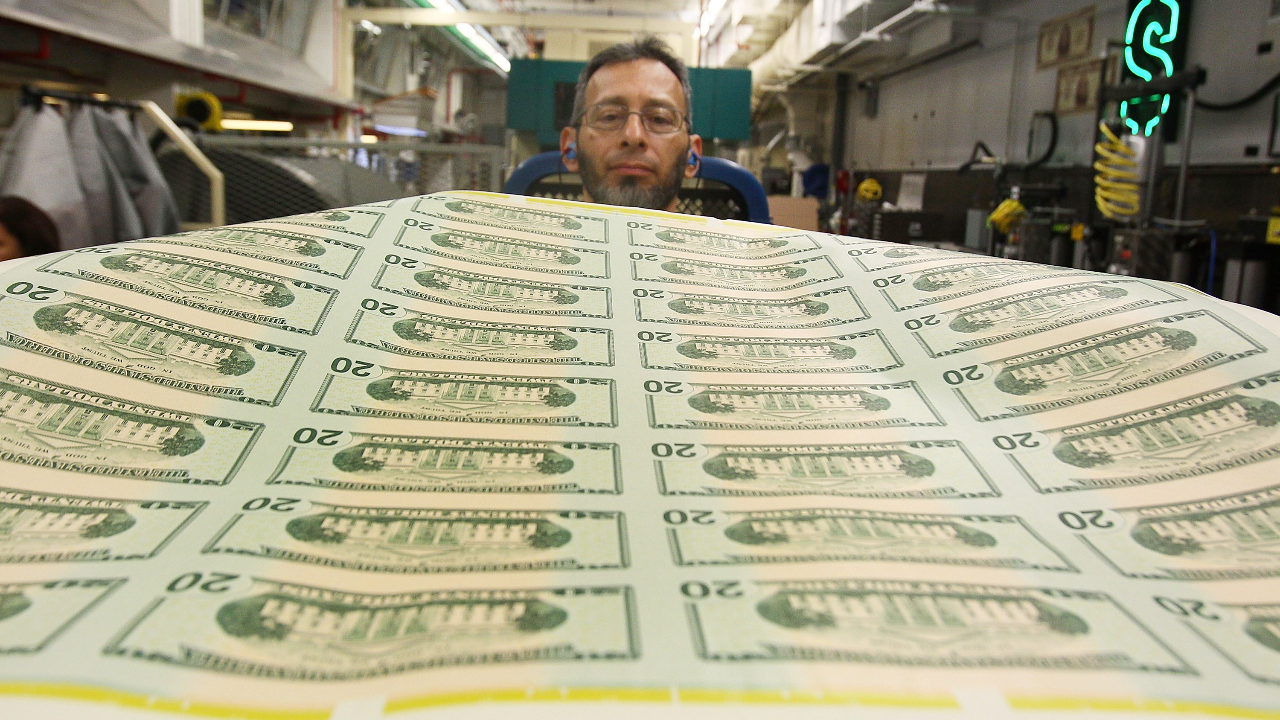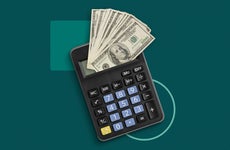Negative interest rates, explained — and how they work

The Bankrate promise
At Bankrate we strive to help you make smarter financial decisions. While we adhere to strict , this post may contain references to products from our partners. Here's an explanation for .
Imagine a world where you pay a bank to hold onto your cash and a bank pays you to take out a loan. This isn’t an alternate dimension — it’s what supposedly happens when interest rates turn negative.
Negative interest rates are an unconventional economic concept that could turn the world of banking on its head. Federal Reserve Chairman Jerome Powell has repeatedly talked down the idea of below-zero borrowing costs in the U.S., though consumers may be feeling uncomfortably close to that reality already, with bond yields tumbling to record lows and the Fed slashing rates to zero.
Central banks in Europe and Japan have already cut into negative territory, and yields on shorter-term Treasury bills that mature in one year or less have already dipped below zero. But it comes with fine print: Those policies often come with mixed results and could cause more problems than they solve.
“It’s the central bank equivalent of throwing something against the wall to see if it sticks,” says Greg McBride, CFA, Bankrate chief financial analyst. “That’s why negative interest rates are not proven to be effective. They are still nothing more than an experiment.”
Here’s what you need to know about negative interest rates, including how they work and how they can impact you, whether you’re a borrower, saver or investor.
What are negative interest rates?
Negative interest rates are exactly what they sound like — it’s when an interest rate dips below 0 percent. They can come from two different angles: yields on bonds and Treasury securities can go negative, as can the federal funds rate, the Fed’s main economy-guiding lever.
That borrowing cost is a benchmark for other rates throughout the economy. When the Fed votes to raise it, it becomes more expensive to take out a loan, slowing down growth. When officials decide to lower it, it becomes less expensive, propelling the economy forward and acting as a boost to growth.
It seems counterintuitive, but it’s not as impossible as it sounds. Government debt in several advanced economies are already trading in negative territory, such as Germany, France, Denmark and the Netherlands right now. They were also once sub-zero in Belgium.
Meanwhile, the Riksbank of Sweden, the oldest central bank in the world, was among the first to implement what’s now known as a negative policy rate, when it announced in 2009 that it would charge banks to hold deposits. Technically, however, the central bank of Denmark in 2012 became the first to bring its key policy rate below zero. Today, the European Central Bank’s (ECB) interest rate for deposits is minus 50 basis points, while the Bank of Japan’s (BOJ) short-term interest rate target is minus 10 basis points.
“Negative rates have been one of the unconventional policy tools [used] since the global financial crisis,” says David Lebovitz, executive director and global market strategist at J.P. Morgan Asset Management. “If you look at any traditional income textbook, there is no mention of negative interest rates. This has been an experiment over the course of the past decade, with the main players being people like the ECB and the central bank of Sweden.”
How negative rates work
Negative interest rates operate in an upside-down world of banking. Instead of a bank paying you to park your cash in a savings account or a certificate of deposit (CD), you’ll (theoretically) have to pay them to hold onto your cash. Think of it like a storage fee. And instead of having to pay interest on a loan if you go out and buy a car, you’ll (supposedly) earn a little bit of money with negative rates.
“It flips the banking model on its head,” McBride says.
Negative rates for consumers wouldn’t just one day happen on its own. It’d likely be determined based on the interest rate that the Fed sets: the federal funds rate. If officials decided to cut that benchmark borrowing cost, they’d then elect to charge banks a fee for parking their reserves in accounts at the Fed. Banks would then pass that policy rate on to consumer products, meaning it’d get filtered through to the rest of the economy.
“A negative rate means you are more concerned with the return of capital rather than the return on capital,” Lebovitz says.
That’s only part of the picture. Bond yields can also offer a negative net return, with or without the Fed’s help. To explain why, it’s important to remember how bond yields generally work: When prices rise, the return that they generate falls, meaning heightened demand could push yields below 0 percent. But technically speaking, a negative-yielding bond is simply one that gives back less money than what was spent on the initial investment.
“A negative bond yield doesn’t mean that the lender has to pay the borrower a coupon rate,” McBride says. “It just means that the price has been bid so high that even with the coupon income over the life of the bond, you still are not going to make a profit when you get your principal back at maturity.”
What’s the purpose of negative rates?
Central banks and other countries have introduced negative interest rates for a variety of reasons — mainly reserving them for the most desperate of times, economically speaking. They’ve been touted as methods to spur intense borrowing and spending, to push inflation back up to target and to devalue a country’s currency, boosting trade.
Coming out of the Great Recession, central banks around the world were struggling to revive their economies. While the Fed slashed rates to zero and instituted a massive bond-buying program to push down longer-term rates, the ECB and BOJ set their sights on something more.
Fearing a deflationary trap, these central banks started betting that negative rates would spur intense levels of borrowing and spending. After all, why would a consumer prefer to keep their money in an account at a bank, when they could be borrowing money and making a profit? And why would a bank not lend out to businesses and consumers when they’d be penalized for holding onto cash at the Fed?
“The idea of bringing policy rates and interest rates broadly into negative territory is really to stimulate the flow of credit and to essentially encourage risk-taking on the part of consumers and investors,” Lebovitz says. “It’s meant to incentivize people to borrow money and take more risk.”
Even trickier, officials theorized that negative rates could devalue the country’s currency. It would push foreign investors out and cause an uptick in demand for the country’s exports. That’s been a major talking point for President Donald Trump — one of the main reasons why he pressured officials throughout 2019 to reduce rates to “zero or lower.”
What are the major consequences of negative rates?
Experts say negative interest rates don’t always lead to the outcomes economic theory would suggest, stirring up concerns of bank runs and profitability if they’re ever implemented.
Lenders want to be compensated for loaning out to a potentially risky borrower. That means if yields were to turn negative, it’d be unlikely for you to get paid to take out something like a mortgage or an auto loan, and even more so, banks might not want to write out those loans, McBride says.
“They don’t want to do it from a business perspective,” McBride says. “Rates might be low, but it doesn’t eliminate the risk of lending.”
But in theory, lower-risk borrowers might be able to get away with taking out a loan at a modesty negative rate, which occurred in Switzerland, says Bill English, finance professor at the Yale School of Management who spent more than 20 years at the Fed.
Lenders also make money off of interest rates. Such a policy could squeeze their profits, ultimately deterring them from lending even more, which could then needlessly slow down the economy. That’s been the case in the current countries where negative rates have taken hold.
There’s also a clear concern that negative yielding consumer products could cause bank runs. People might prefer to keep their money under their mattress, where the interest rate is at least 0 percent. That’s made banks all the more reluctant to pass on negative rates.
Another concern is that a too-low negative federal funds rate could discourage banks from keeping deposits at the Fed, English says. Instead, they could opt to convert their reserves to currency, which could strain the financial system. Experts often call this a “reversal rate.”
And just as it was difficult for the Fed to hike rates in 2018 during a time of solid economic growth, it’s hard to shake the negative interest rate cycle once it begins. The ECB, BOJ and Bank of Switzerland are still in the negative zone, despite the recession ending more than a decade ago. Experts say their economies aren’t in any better shape now than before those policies were implemented.
“If the demand materialized and you saw credit flowing through the economy, you could move interest rates back out of negative territory,” Lebovitz says. “Now, they’re stuck with negative rates. We’ve seen them throw their hands in the air and say, ‘This isn’t really boosting inflation and reviving economic growth by increasing risk taking.’”
Other former and current central bankers have also warned about potential economic woes, mainly on the grounds that there isn’t enough research to suggest whether negative rates could help.
The Fed doesn’t “want to take a chance by undermining profitability in the banking sector or moving rates into negative territory without proof” that it could work, says Lebovitz. “They would really need to be out of bullets and grasping at straws.”
How negative rates would impact you
It doesn’t look like negative interest rates will be happening in the U.S. anytime soon. Still, if things got really bad, English says he could imagine the Fed changing its tune.
If that happens, individuals who are saving or living off fixed income would be left behind, just as savers and retirees haven’t benefited from more than a decade of ultra-low rates.
“Think about what you’re getting paid on your checking account today, and imagine relying on that to fund your day-to-day activities,” Lebovitz says. “If you think zero rates are causing a problem for folks like that, negative rates are going to exacerbate it.”
Banks, however, are more likely to charge customers fees rather than an outwardly negative interest rate because it’s easier to communicate, says Gary Zimmerman, founder and CEO of MaxMyInterest.com. And the larger the balance, the less a bank will want your money. Firms are swimming in deposits and struggling to find profitable, reliable avenues of lending, meaning they’ll be forced to turn around and park those funds back at the Fed for a cost.
“The whole intent of negative interest rates would be to incentivize banks to turn around and lend the money,” Zimmerman says. “But the problem is, there just aren’t enough good lending opportunities.”
But bondholders of negative yields seem to believe there’s a way to game the system. Buying a sub-zero bond and holding it until maturity is a guaranteed way to lose money, but if you sell it as prices continue to rise, you’ll end up making more cash while also holding onto a safe-haven investment.
“People buying bonds at negative rates, they’re gambling that the rate is going to go lower,” McBride says. “If they hold it to maturity, they’re going to guarantee a loss.”
The bottom line is, consumers won’t benefit from this policy, McBride says. Continue shopping around for the best rate and account on the market for you. And even if banks slash yields to zero, you’re still better off keeping money in the bank than putting it under your mattress, he says.
“It’s federally insured, and you’re completely protected from loss,” McBride says. “You put that money under the mattress, you’re in no protection against loss or theft.”
Learn more:
- The repo market, explained — and why the Fed keeps pumping hundreds of billions into it
- No, the Fed cutting rates to zero will not lead to 0% mortgage rates
- 8 best low-risk investments
Featured image by Mark Wilson of Getty Images.
Related Articles



